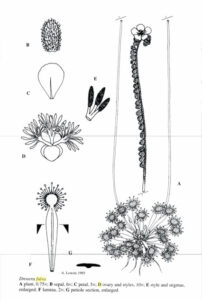Drosera Fulva Information
Drosera fulva Planchon
Ann. Sci. Nat. (Paris) ser. 3, 9: 289 (1848)
A tropical, fibrous-rooted perennial plant with a crowded, compact rosette of semi-erect and prostrate leaves at anthesis. All leaves of the basal rosette are prostrate and much reduced in length during the growth period; the basal portion of each rosette forming a bulb-like arrangement which is an accumulation of fleshy leaf bases. Active leaves at anthesis glabrous. In the lead up to dormancy all leaves develop a covering of white, appressed dendritic hairs.
Leaf -lamina orbicular, 2–3 mm diam.; retentive glands around margins of the lamina, smaller glands within; lower surface covered with a few appressed simple white hairs at anthesis, towards dormancy covered with white dendritic hairs; petiole oblanceolate, 0.6-1.2 mm wide at the base, 2-3 mm wide near apex then narrowed to 0.8-1 mm wide at lamina, up to 3 cm long at flowering, the upper surface glabrous, lower surface sparsely covered with a few appressed simple white hairs, later both surfaces covered with white dendritic hairs.
Inflorescence – a 1-sided raceme with 50 or more crowded flowers, including scape 25-45 cm long, densely covered with short dendritic hairs; scape glabrous, commonly the same length as the raceme; pedicels |—2 mm long, pendulous in fruit.
Sepals – obovate, 3-3.5 mm long, |.5—1.8 mm wide, erose at apex, densely covered with dendritic hairs.
Petals – white, often pink, obovate, erose at apex, 6.5—9 mm long, 4—-6.5 mm wide.
Stamens – 5, 3 mm long; filaments white, shortly pointed and exceeding anthers; anthers and pollen yellow.
Ovary – green, obovoid, 0.8—1 mm long, 1.2—1.5 mm diam.
Styles – 3, 2 mm long, white, each once-forked, then divided into about 16 segments; stigmas slightly dilated at the apex of each style segment, papillose.
FLOWERING: February—May. Dormancy dry.
Habitat: Grows in sandy soil on damp flats, seepage areas, and ephemeral wet depressions just above the wet season flood levels.
Location: N.T.—Howard Springs, Palmerston, Humpty Doo.
The type material of D. fulva was collected by John W. Armstrong, botanist, appointed gardener and botanical collector for the Royal Gardens at Kew at the military settlement then called Victoria (1838-1849), at Port Essington, north Australia (N.T.). No date or precise locality on the Cobourg Peninsula was given.
Drosera fulva in active growth has glabrous leaves. After flowering and towards dormancy, all leaves produced are covered with dendritic hairs. Dz fulva is a long flowering species. Inflorescences past anthesis are held well into the dry season. Distinguished from D. dilatato-petiolaris (to which it is closely related) by its inflorescence (including scape) 25-45 cm long, pedicels 1-2 mm long, and pendulous fruit.
